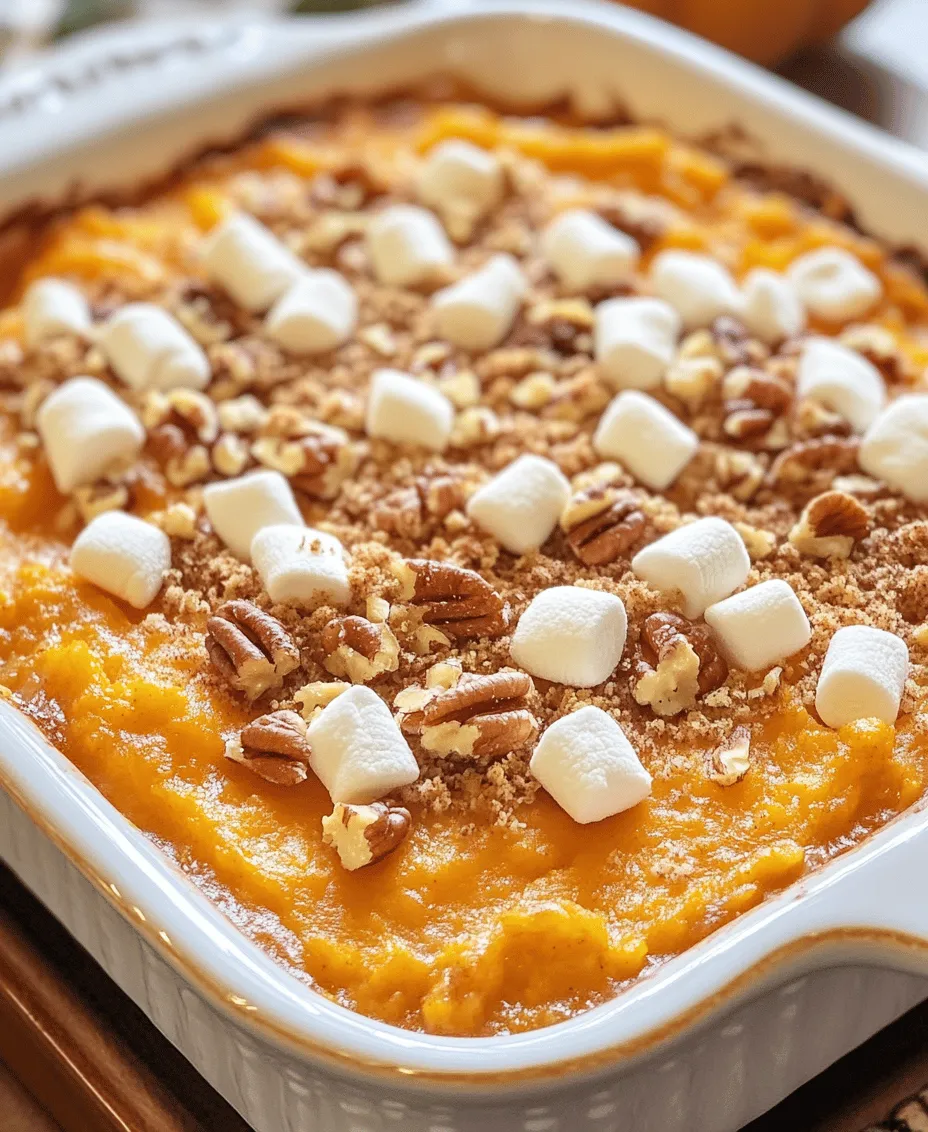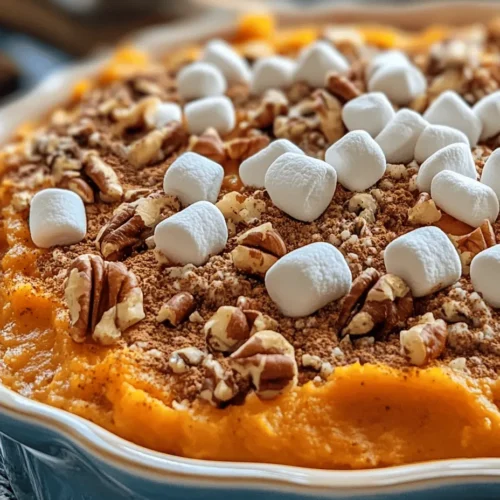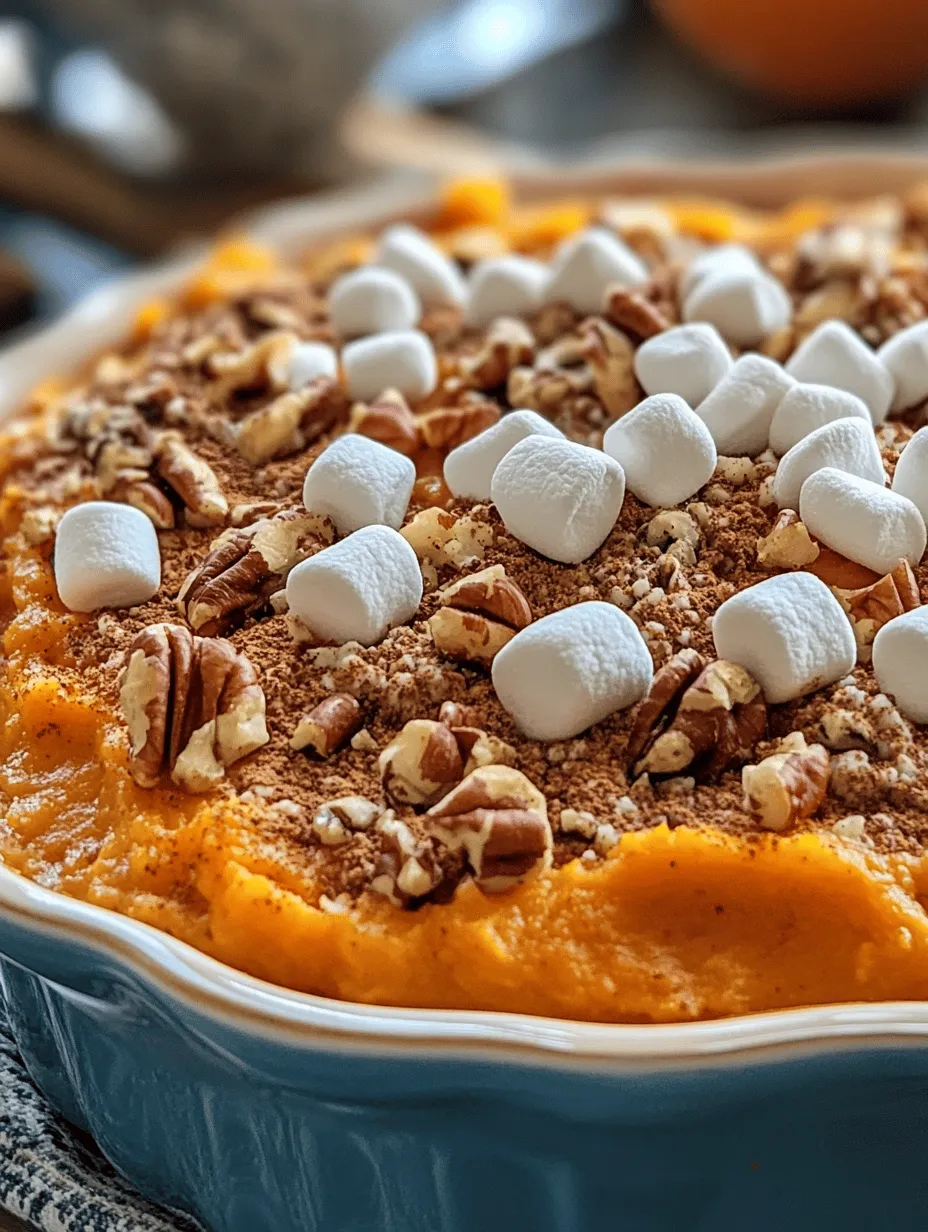Introduction
As the leaves turn golden and the air becomes crisp, the aroma of warm, comforting dishes begins to fill our homes. One such dish that embodies the spirit of the fall and holiday seasons is the sweet butternut squash casserole. This delightful casserole not only brings a vibrant pop of color to your table but also offers a sweet and savory flavor profile that is sure to please both family and friends. Whether served as a side dish during Thanksgiving dinner or as a comforting comfort food on a chilly evening, this casserole is a timeless classic that celebrates the flavors of autumn.
Butternut squash, the star of this dish, is celebrated for its versatility and nutritional benefits. This winter squash, with its smooth texture and naturally sweet taste, pairs beautifully with warm spices and creamy ingredients, making it perfect for a cozy casserole. In this recipe, we will explore how to create a perfect sweet butternut squash casserole that highlights the best of this seasonal ingredient.
Casseroles have long been a staple in home cooking, offering both convenience and comfort. They are wonderful for feeding a crowd, can often be prepared in advance, and allow for creativity in the kitchen. By layering flavors and textures, casseroles can turn simple ingredients into something extraordinary. Let’s delve deeper into the wonders of butternut squash and the essential components of this comforting dish.
Understanding Butternut Squash
Nutritional Benefits of Butternut Squash
Butternut squash is not only delicious but also packed with nutrients. It is an excellent source of vitamins A and C, both of which are essential for maintaining a healthy immune system and promoting good vision. Additionally, butternut squash is high in dietary fiber, which aids in digestion and helps keep you feeling full longer. With its low-calorie count and rich array of antioxidants, this squash is a fantastic addition to a balanced diet, especially during the fall months when it is in season.
Flavor Profile and Culinary Uses
The flavor of butternut squash is often described as nutty and sweet, with a creamy texture that makes it incredibly versatile in the kitchen. It can be roasted, pureed, or mashed, and it pairs beautifully with a variety of spices and ingredients. Commonly used in soups, salads, and side dishes, butternut squash shines in both sweet and savory recipes. Its natural sweetness makes it a perfect candidate for casseroles, where it can be enhanced with spices like cinnamon and nutmeg, while also complementing richer flavors such as butter and cream.
Seasonal Availability and Selection Tips
Butternut squash is typically in season from late summer through the fall, making it a popular ingredient in autumn recipes. When selecting butternut squash, look for firm, heavy squashes with a smooth, tan skin. Avoid any with soft spots or blemishes, as these may indicate spoilage. A good butternut squash should feel dense and have a deep orange color at the base, which is a sign of ripeness. Once harvested, butternut squash can be stored in a cool, dry place for several weeks, making it an ideal ingredient to keep on hand for seasonal cooking.
Ingredients Breakdown
To create a delicious sweet butternut squash casserole, you’ll need a combination of fresh ingredients that work together to create a rich and flavorful dish. Let’s break down each ingredient and its role in the recipe:
Butternut Squash: Preparation and Cooking Techniques
The star ingredient, butternut squash, is the foundation of this casserole. To prepare butternut squash, you will need to peel the skin using a vegetable peeler, then cut it in half lengthwise and scoop out the seeds with a spoon. Once prepped, you can cube the squash into bite-sized pieces. Cooking methods vary, but you can either steam, boil, or roast the squash until tender. Roasting brings out the natural sweetness and caramelizes the edges, enhancing the flavor of the casserole.
Brown Sugar: Its Role in Flavor and Texture
Brown sugar adds a delightful sweetness to the casserole, balancing out the savory notes of the squash and spices. It also contributes moisture and a lovely caramelized texture when baked. The molasses content in brown sugar provides a deeper, more complex flavor compared to white sugar, making it an ideal choice for this dish. Adjust the amount based on your preference for sweetness, but remember that a little goes a long way in creating that comforting fall flavor.
Unsalted Butter: Importance of Fat in Casseroles
Fat is essential in casseroles for both flavor and texture, and unsalted butter plays a crucial role in this recipe. It adds richness and depth, helping to bind the ingredients together while also contributing a creamy mouthfeel. Using unsalted butter allows you to control the salt content in the dish, ensuring a perfectly seasoned casserole. Be sure to melt the butter before incorporating it into the mixture for even distribution and a smooth texture.
Spices: Enhancing Flavors with Cinnamon, Nutmeg, and Ginger
The warm spices of cinnamon, nutmeg, and ginger are what truly elevate the flavors of the butternut squash casserole. These spices not only complement the sweet notes of the squash and brown sugar but also add a comforting warmth that resonates with the season. Cinnamon brings a familiar sweetness, nutmeg adds a hint of nutty complexity, and ginger introduces a slight zing that rounds out the flavor profile beautifully. Adjust the spices to your liking, but a balanced blend is key to achieving that quintessential autumn taste.
Vanilla Extract: Adding Depth to the Dish
A splash of vanilla extract enhances the overall flavor of the casserole, adding a subtle sweetness and depth that pairs well with the squash and spices. It helps to round out the flavor profile and can elevate the dish from simple to extraordinary. When choosing vanilla extract, opt for pure extract for the best flavor; imitation vanilla may not provide the same complexity.
Eggs and Milk: Binding Agents and Moisture Providers
Eggs and milk are essential to the structure of the casserole, acting as binding agents that hold the ingredients together. Eggs provide richness and stability, helping the casserole to set properly as it bakes. Milk adds moisture and creaminess, creating a luscious texture that makes each bite comforting. Whole milk is recommended for a creamier casserole, but you can use lower-fat alternatives if desired.
Optional Toppings: Crushed Pecans and Mini Marshmallows
To add a delightful crunch and contrasting texture to the casserole, consider topping it with crushed pecans before baking. The nuts will toast and create a lovely golden crust that adds both flavor and visual appeal. Alternatively, for a sweeter twist, mini marshmallows can be sprinkled on top. As they bake, the marshmallows will melt and turn golden brown, creating a sweet, gooey topping that children and adults alike will love. You can choose one option or combine both for a unique topping experience.
Preparation Steps
Now that we’ve explored the ingredients, it’s time to dive into the preparation steps for creating a sweet butternut squash casserole. The process is straightforward and involves a few key steps to ensure that your casserole turns out perfectly.
Prepping the Butternut Squash: Peeling, Cubing, and Cooking Instructions
1. Peeling the Squash: Start by washing the butternut squash thoroughly under running water. Using a vegetable peeler, carefully remove the skin, being mindful of the curves and contours of the squash. This may take a bit of effort, but the smooth flesh is worth it.
2. Cutting the Squash: Once the squash is peeled, place it on a cutting board and slice it in half lengthwise. Use a spoon to scoop out the seeds and stringy insides. Discard the seeds or save them for roasting later. Cut each half into manageable sections, and then cube the squash into approximately 1-inch pieces.
3. Cooking the Squash: You can choose to steam, boil, or roast the cubed squash. If steaming, place the cubes in a steamer basket over boiling water for about 10-15 minutes, or until they are fork-tender. For boiling, cook the cubes in salted water for about 10 minutes, then drain. Roasting, however, is the preferred method: preheat your oven to 400°F (200°C), toss the cubes with a little olive oil, salt, and pepper, and roast for about 25-30 minutes, or until they are tender and caramelized.
Mashing Techniques for Achieving the Right Consistency
Once the squash is cooked, it’s time to mash it for your casserole. For a creamy texture, you can use a potato masher or a fork to mash the squash until smooth. If you prefer a silkier consistency, a food processor can be used; simply pulse until you reach the desired smoothness. Be careful not to over-process, as this can lead to a gluey texture.
As you mash, gradually incorporate the melted unsalted butter, brown sugar, vanilla extract, and spices into the squash. Mix until well combined, and then add the eggs and milk, ensuring a smooth and homogenous mixture. This step is crucial for achieving the right balance of flavors and textures in your casserole.
By taking the time to prepare your butternut squash and flavoring it with care, you set the foundation for a delightful sweet butternut squash casserole that will be a highlight of any autumn gathering. Stay tuned for the subsequent steps where we will combine all the elements and bake this comforting dish to perfection.

Mixing Process
To create the perfect Sweet Butternut Squash Casserole, it’s crucial to ensure that all ingredients are well combined. Begin by transferring all your prepared ingredients into a large mixing bowl, including the cooked and mashed butternut squash, eggs, brown sugar, spices, and any additional ingredients you’ve chosen to incorporate. Using a whisk or a hand mixer on low speed, blend the mixture until it reaches a smooth and creamy texture. This step is essential as it allows the flavors to meld beautifully, resulting in a harmonious casserole.
If you prefer a slightly chunky texture, you can use a fork to mash the squash while leaving some small pieces intact. This not only adds to the visual appeal but also provides a delightful contrast in texture. Be sure to scrape down the sides of the bowl to incorporate any ingredients that may have stuck to the edges.
Pouring into the Casserole Dish
Once your mixture is well combined, it’s time to transfer it into a prepared casserole dish. To ensure even spreading, use a spatula to gently scoop the mixture from the bowl, placing it evenly into the dish. It’s important to spread the mixture out to the edges, creating an even layer. This will help the casserole bake uniformly, preventing any undercooked spots that could detract from the final dish.
For a neat presentation, you might consider lightly greasing your casserole dish with butter or cooking spray before pouring in the mixture. This step not only helps with easy removal after baking but also adds a subtle richness to the dish.
Optional Toppings
Adding toppings can elevate your Sweet Butternut Squash Casserole to new heights. Consider mixing together some crushed pecans or walnuts with a sprinkle of brown sugar and perhaps a touch of cinnamon for a crunchy topping. These can be added during the last 15 minutes of baking to ensure they stay crisp and do not burn.
Alternatively, for a more decadent touch, you could add a layer of marshmallows on top of your casserole. Place them on the casserole about 10 minutes before it’s done baking, allowing them to caramelize and create a deliciously gooey layer that complements the sweet squash perfectly.
Baking the Casserole
Importance of Proper Oven Temperature and Time
For the best results, preheat your oven to 350°F (175°C) before placing your casserole inside. This temperature allows the casserole to cook evenly, helping to set the eggs and create the desired creamy texture without overcooking. The typical baking time for a Sweet Butternut Squash Casserole ranges from 45 to 60 minutes, depending on the depth of your dish and the specific ingredients used.
Signs of Doneness
During baking, keep an eye on your casserole. You’ll know it’s done when the edges are slightly puffed, and the center has set but may still have a slight jiggle. A toothpick inserted in the middle should come out clean or with a few moist crumbs, but not wet batter. If the top starts to brown too quickly, you can cover it loosely with aluminum foil to prevent burning while allowing the interior to continue cooking.
Cooling Period
Once the casserole has finished baking, it’s essential to allow it to cool for at least 10-15 minutes before serving. This cooling period helps the casserole firm up, making it easier to slice and serve. The flavors also have a chance to meld further, resulting in a more flavorful dish.
Serving Suggestions
Ideal Accompaniments
Sweet Butternut Squash Casserole pairs wonderfully with a variety of proteins and sides. Consider serving it alongside roasted chicken or turkey for a comforting family meal. The casserole also complements pork tenderloin beautifully, adding a touch of sweetness to the savory dish. For a vegetarian option, pair it with a fresh salad or sautéed greens to balance the richness of the casserole.
Presentation Ideas for Special Occasions
For festive gatherings, presentation matters. Transfer the casserole to a beautiful serving dish and garnish with fresh herbs like sage or thyme for a pop of color. You can also drizzle a bit of maple syrup over the top or sprinkle with toasted nuts right before serving for added flair. If you’re feeling creative, consider using a decorative baking dish that matches your table setting, as this can add a personal touch to your meal.
Storage Tips for Leftovers
If you happen to have leftovers, storing them properly is key to maintaining their deliciousness. Allow the casserole to cool completely before transferring it to an airtight container. The casserole can be stored in the refrigerator for up to 4 days. When reheating, place it back in a preheated oven at 350°F (175°C) until warm, which helps retain the texture. For longer storage, you can freeze the casserole for up to 3 months. Be sure to cover it tightly with foil or plastic wrap before freezing and allow it to thaw in the refrigerator overnight before reheating.
The Versatility of the Sweet Butternut Squash Casserole
Variations on the Recipe
One of the greatest aspects of the Sweet Butternut Squash Casserole is its versatility. You can easily adapt the recipe to fit your dietary preferences. For those looking to reduce sugar, consider substituting the brown sugar with natural sweeteners like maple syrup or honey. If you wish to make a dairy-free version, simply replace the eggs with a flaxseed meal mixture (1 tablespoon of flaxseed meal mixed with 2.5 tablespoons of water) and use coconut milk instead of regular milk.
Seasonal Adaptations
This casserole can also be tailored to suit the seasons. In the fall, consider adding dried cranberries or chopped apples to the mixture for a delightful twist. The tartness of cranberries or the sweetness of apples complements the butternut squash beautifully, creating an even more complex flavor profile. Additionally, spices like nutmeg or allspice can be swapped in for a seasonal touch.
Using Butternut Squash in Other Dishes
Beyond casseroles, butternut squash is incredibly versatile in the kitchen. It can be roasted, pureed for soups, or even used in salads. Try incorporating it into pasta dishes, blending it into smoothies for added nutrition, or using it as a filling in quesadillas. The possibilities are endless, allowing you to expand your culinary repertoire while enjoying all the health benefits butternut squash has to offer.
Cultural Significance of Casseroles
The Role of Casseroles in Family Gatherings and Celebrations
Casseroles have long held a special place in American cuisine, often associated with family gatherings and celebrations. They are the epitome of comfort food, providing nourishment and bringing people together. Whether it’s a holiday feast, a potluck, or a simple family dinner, casseroles are often the star of the show, offering familiarity and warmth to those who partake.
Historical Perspective on Casseroles
Historically, casseroles emerged as a practical solution for home cooks, allowing them to use leftover ingredients and minimize waste. The concept of layering ingredients in a dish and baking them together dates back centuries and has evolved into the beloved casserole dishes we know today. They represent resourcefulness in the kitchen and have become a staple in many households across the country.
Comfort Food: How Casseroles Bring People Together
Casseroles are synonymous with comfort, evoking memories of home-cooked meals and family traditions. The act of sharing a casserole at the table often signifies love, care, and togetherness, making it an integral part of many family celebrations. The communal aspect of serving and enjoying a casserole fosters connection, making it a cherished dish in homes everywhere.
Conclusion
The Sweet Butternut Squash Casserole is not only a delicious and comforting dish but also a versatile recipe that can be adapted to suit various tastes and dietary preferences. Its rich flavors and textures make it an appealing option for any occasion, whether it’s a holiday feast or a weeknight dinner. The ability to personalize the recipe and the cultural significance of casseroles as a comfort food highlight their enduring appeal in our culinary landscape.
As you explore this recipe, don’t hesitate to make it your own by experimenting with different ingredients and flavors. Share your experiences, adaptations, and even your favorite family traditions centered around casseroles. After all, the joy of cooking lies not just in the end result but in the memories created along the way. Enjoy your culinary journey with butternut squash, and savor the moments shared with your loved ones around the table.



